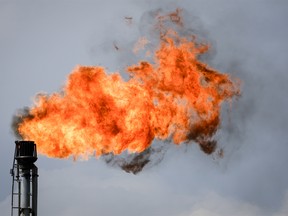The policy would leave Canada as the only major global oil and gas export nation facing such a cap

The Trudeau government’s draft regulations to cap oil and gas sector emissions will be unveiled Monday, with Ottawa insisting a planned 35 per cent emissions reduction by the end of the decade isn’t intended to shut in Canadian production.
And it could allow for more output, the federal government says.
But it’s sure to ignite the next round in a bruising battle between the federal government and Alberta over the contentious policy and its impact on future oil and gas output in Canada.
The federal government will introduce details Monday on a planned cap-and-trade system, first promised by the Liberals during the 2021 election campaign, to limit industry emissions.
The regulations are designed around what is feasible for the sector to lower its greenhouse gas emissions, federal Natural Resources Minister Jonathan Wilkinson said in an interview.
According to the federal government, its analysis shows that with the cap in place, oil and gas output is projected to increase 16 per cent (by 2030 to 2032) from 2019 levels, provided the industry adopts “technically achievable” decarbonization measures.
“It is not intended to keep oil in the ground. It is intended to ensure that we are limiting emissions,” Wilkinson said.
“The industry itself will probably not be overly happy, but at the end of the day, I think that the way we’ve designed the cap, they will take some comfort from the fact that it is really based on technical achievability. It is not based on shutting in production.”
The cap-and-trade system would impact the largest emitting industry in the country. It will cover upstream oil and gas facilities, including the oilsands, conventional oil and gas production and processing, offshore production and LNG developments.
The system would establish a total quota of allowable emissions for the entire sector, with Ottawa distributing free allowances to regulated facilities, and the allowances shrinking over time.
The plans are equivalent to a framework for the cap released by the federal government last December, which strived to lower industry emissions by 35 to 38 per cent below 2019 levels by the decade’s end.
Aside from cutting their emissions, companies can use flexibility measures to reduce that number by purchasing carbon offsets or investing in a decarbonization fund.

Last year, the federal government estimated the flexibility mechanisms would bring the number down to 20 to 23 per cent. Wilkinson said the new figures are “in that bound,” although specific data is expected to be released Monday.
“The cap is 35 per cent below 2019, so it’s the bottom end of the range that was in the framework,” he said.
The proposed regulations would use emissions data that operators would have to submit annually, starting in 2026, for the first compliance period in 2030-32.
Final regulations will be published next year, following consultations.
The policy would leave Canada as the only major global oil and gas export nation facing such a cap.
“Ottawa says they are working to cut emissions, but we all know what they’re really doing is cutting production of oil and gas and this, by extension, will cut jobs and revenues across the country,” Premier Danielle Smith said at a news conference.
“It would not only be devastating for Alberta, but for everyone from Newfoundland, Saskatchewan to British Columbia.”
The province points to several studies about the potential economic ramifications for Alberta and the country.

A report by Deloitte for the Alberta government projected the federal regulations could lead to a 10 per cent reduction in Canadian oil production and 12 per cent drop in natural gas output by 2030.
A separate study for the province by the Conference Board of Canada says the oil and gas industry can take lower-cost steps to reduce its methane emissions, but there would be a gap to reach Ottawa’s emissions goal.
It estimates the cap would lead to lower production growth — down about 11 per cent from its base case — as oil and gas are left in the ground. It also spells out a broader economic fallout, including up to 151,000 jobs lost by the end of the decade.
Canada is the fourth-largest oil producer in the world.
The industry is the largest emitting sector in the country. In 2022, it was responsible for 31 per cent of all emissions, while oilsands growth has risen over the past 25 years.
As part of its climate commitments, Canada has adopted a net-zero target by 2050, and has set a goal of curbing emissions by 40 to 45 per cent by the end of the decade.
“The cap is a specific tool and it’s largely intended to backstop action by the industry,” the federal minister said.
Pathways Alliance, which includes companies such as Suncor Energy, Canadian Natural Resources and Cenovus Energy, is talking with the federal and provincial governments about incentives to build a $16.5-billion carbon capture network in northern Alberta.
A final investment decision has not yet been made on the project.

It’s unclear what impact the policy will have on those discussions, but producers have been adamant a cap isn’t needed as they adopt new technology to lower their emissions.
“Moving forward with Pathways would be a better, a much better, solution than a production cap on the industry,” Scott Stauth, president of Canadian Natural Resources, said in an interview last week.
“The industry does not need an emissions cap. We need support to go forward with a project such as Pathways, that will, over time, reduce emissions while protecting jobs, protecting income taxes from those jobs, protecting royalties for the provinces.”
Unlike studies for the province showing a huge hit on the Alberta and Canadian economy, the federal documents say its own modelling indicates the proposed regulations will have a net benefit of $428 million for Canada, when compared to the costs.
Chris Varcoe is a Calgary Herald columnist.